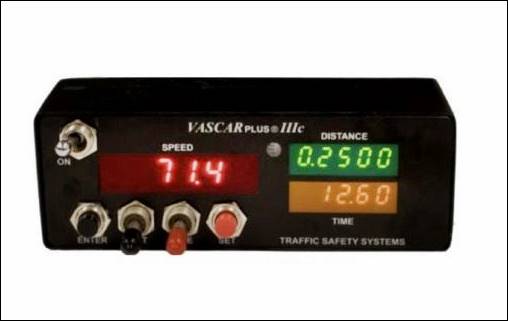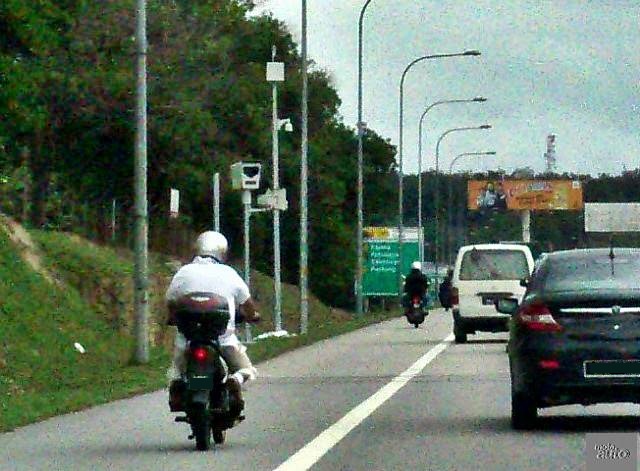Speed traps using cameras have been used in Malaysia since the 1970s when equipment supplied by Gatso was acquired by the PDRM.
The Gatso cameras, which became popular with law enforcement authorities worldwide, were invented by former racing driver Maurice Gatsonides in Holland. He had intended them to record his speeds on the track but then found the technology could also be used to make motoring safer by helping police identify law-breakers.
VASCAR
Besides handheld cameras, the police force also installed VASCAR (Visual Average Speed Computer And Recorder) in some patrolcars.
The VASCAR system used two points on a road as reference points and as a car passed the first point, the computer was started and then stopped after it passed the second point. Immediate calculation told the policemen in the car whether the vehicle had exceeded the speed limit and they would either pursue it, or inform others further down the road to stop the car and issue a summons.

The VASCAR system was tested in various parts of the country, including the Federal Highway in Selangor where a popular spot was between the Jalan Gasing and Jalan Timur turn-offs (no flyovers in the early 1970s). The VASCAR system was liked by enforcement authorities as it did not use radar and drivers could not be alerted by radar detectors.
However, the PDRM didn’t use it for long, perhaps because it relied on a human to operate and could be inaccurate, leading some police forces to stop using it.
The PDRM has since relied largely on the handheld camera guns which got more sophisticated using laser, able to ‘shoot’ over longer distances, and also had infrared capability for night operations.
First automated cameras
The first automated speed cameras in Malaysia were installed along the Karak Highway in the late 1980s. Costing RM854,000, they were supplied by Gatso and powered by sunshine converted into electricity by solar panels on top of the cameras. Thirteen units were installed along the highway which, at that time, ended at Karak.
In the first 3 weeks of operation, over 5,000 motorists were photographed breaking the speed limit which was 80 km/h in the early years but increased to 90 km/h after 1997 when the highway was upgraded.

It was before the digital age so the cameras used film which had to be collected regularly and then processed (same for traffic light cameras in major towns).
As the cameras relied on solar power, there were some times (usually in the monsoon months) when there were long periods of rain so limited sunshine was available and the cameras did not run.
Of course, motorists would not know when they were not operational. The cameras scanned the road using K-band radar which was a common bandwidth most radar detectors could pick up. But radar detectors were illegal in the country so most people did not have them.
Those with good memories (like one veteran rally driver) could remember the locations of each camera.
It’s hard to say when the cameras on the Karak Highway were decommissioned but during the late 1990s, there was news that the cameras were no longer operational. Bold motorists ‘tested’ them by exceeding 90 km/h and found that no summons came in the post. Eventually, it was reported that they were no longer in use but the installations (surrounded by fencing) remained with the plants slowly growing around them.
Left to ‘disintegrate’
When questions were raised about why they were not dismantled, an official response was that the cost of doing so was high, so it was better to just leave them there to ‘disintegrate’. Over time, they were probably removed by various people for scrap and nothing remains of their existence today. Only those who had installed them probably remember the exact spots they were located at.

The police reverted to using speed cameras along the highway and one ‘popular ‘spot was the steep slope after the Genting tunnel where motorists would not realise their car speeded up past the 90 km/h limit (the policeman usually hid in the drain). There was also another spot on the righthand curve coming down from the Genting tunnel near the spot where the billboard for brake pads was located.

Today, handheld cameras are still widely used as well as the Transport Ministry’s AES (Automated Enforcement Systems). Many people refer to the automated cameras installed 10 years ago as ‘AES cameras’ but they are now actually part of the ministry’s ‘AES’. These are known as AWAS (Automated Awareness Safety system) cameras and there are known to be 45 of them. In total, the ministry says that there are 831 cameras is use nationwide – 566 for speeding and 265 at traffic light junctions, of which 250 units are mobile handheld units.

